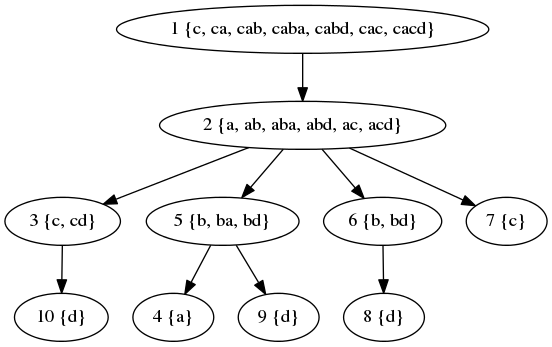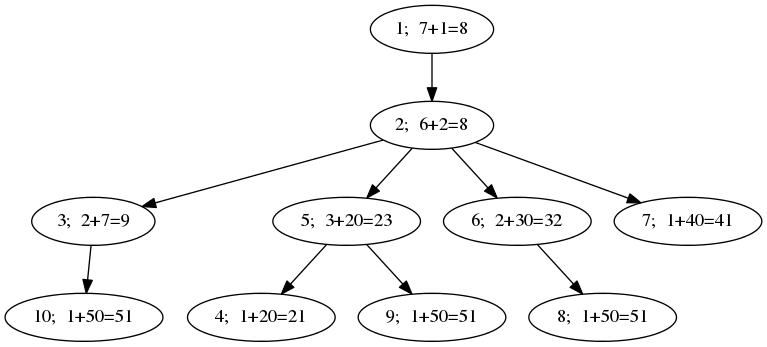2585.Acyclic Organic Compounds
Time Limit: 1s Memory Limit: 256MBYou are given a tree T with n vertices (numbered 1 through n) and a letter in each vertex. The tree is rooted at vertex 1.Let's look at the subtree Tv of some vertex v. It is possible to read a string along each simple path starting at v and ending at some vertex in Tv (possibly v itself). Let's denote the number of distinct strings which can be read this way as  . Also, there's a number cv assigned to each vertex v. We are interested in vertices with the maximum value of
. Also, there's a number cv assigned to each vertex v. We are interested in vertices with the maximum value of  .You should compute two statistics: the maximum value of
.You should compute two statistics: the maximum value of  and the number of vertices v with the maximum
and the number of vertices v with the maximum  .
.
Input Format(From the terminal/stdin)
Input The first line of the input contains one integer n (1 \le n \le 300000)- the number of vertices of the tree.The second line contains n space-separated integers ci (0 \le ci \le 109).The third line contains a string s consisting of n lowercase English letters- the i-th character of this string is the letter in vertex i.The following n-1 lines describe the tree T. Each of them contains two space-separated integers u and v (1 \le u,v \le n) indicating an edge between vertices u and v.It's guaranteed that the input will describe a tree.
Output Format(To the terminal/stdout)
Output Print two lines. On the first line, print  over all 1 \le i \le n. On the second line, print the number of vertices v for which
over all 1 \le i \le n. On the second line, print the number of vertices v for which  .
.
Sample Input 1
10 1 2 7 20 20 30 40 50 50 50 cacabbcddd 1 2 6 8 7 2 6 2 5 4 5 9 3 10 2 5 2 3\n · · · · · · · · · \n \n · \n · \n · \n · \n · \n · \n · \n · \n · \n
Sample Output 1
51 3\n \n
Sample Input 2
6 0 2 4 1 1 1 raaaba 1 2 2 3 2 4 2 5 3 6\n · · · · · \n \n · \n · \n · \n · \n · \n
Sample Output 2
6 2\n \n
Hints
In the first sample, the tree looks like this:  The sets of strings that can be read from individual vertices are:
The sets of strings that can be read from individual vertices are:  Finally, the values of
Finally, the values of  are:
are:  In the second sample, the values of
In the second sample, the values of  are (5,4,2,1,1,1). The distinct strings read in T2 are
are (5,4,2,1,1,1). The distinct strings read in T2 are  ; note that
; note that  can be read down to vertices 3 or 4.
can be read down to vertices 3 or 4.